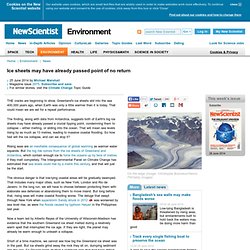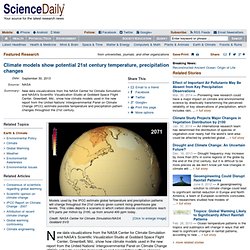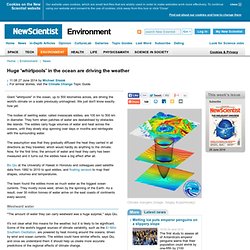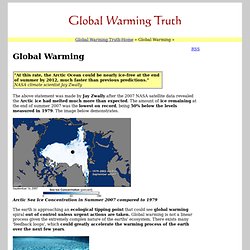Climate Change
> Environment
Arctic melting and darkening
Social issues. Drought and fires. Extinctions. Causes. Climate Change. Climate report 2014: Your guide to the big questions. Cookies on the New Scientist website close Our website uses cookies, which are small text files that are widely used in order to make websites work more effectively.

To continue using our website and consent to the use of cookies, click away from this box or click 'Close' Find out about our cookies and how to change them Log in Your login is case sensitive I have forgotten my password close My New Scientist Look for Science Jobs. 30,000-year-old virus from permafrost is reborn. French scientists said Monday they had revived a giant but harmless virus that had been locked in the Siberian permafrost for more than 30,000 years.

Has the Time Come to Try Geoengineering?
Ice sheets may have already passed point of no return - environment - 25 June 2014. THE cracks are beginning to show.

Greenland's ice sheets slid into the sea 400,000 years ago, when Earth was only a little warmer than it is today. That could mean we are set for a repeat performance. The finding, along with data from Antarctica, suggests both of Earth's big ice sheets may have already passed a crucial tipping point, condemning them to collapse – either melting, or sliding into the ocean. That will mean sea levels rising by as much as 13 metres, leading to massive coastal flooding.
Climate change: Unstable Atlantic deep ocean circulation may hasten 'tipping point'
Climate models show potential 21st century temperature, precipitation changes. New data visualizations from the NASA Center for Climate Simulation and NASA's Scientific Visualization Studio at Goddard Space Flight Center, Greenbelt, Md., show how climate models used in the new report from the United Nations' Intergovernmental Panel on Climate Change (IPCC) estimate possible temperature and precipitation pattern changes throughout the 21st century.

For the IPCC's Physical Science Basis and Summary for Policymakers reports, scientists referenced an international climate modeling effort to study how Earth might respond to four different scenarios of carbon dioxide and other greenhouse gas emissions throughout the 21st century.
How much hotter is the planet going to get? - environment - 09 March 2014.
Read full article Continue reading page |1|2 The climate is highly sensitive to carbon dioxide, according to several new studies, which means that our greenhouse gas emissions will lead to strong warming.

The finding suggests we need to cut emissions fast if we are to avoid dangerous climate change.
Sun Rises Two Days Early. Sun Rises Two Days Early in Greenland.

An event has happened that has the locals searching for answers. The Sun has actually risen 2 days early in Greenland. It was supposed to rise today, January 13th, like it does every year in recorded history.
Huge 'whirlpools' in the ocean are driving the weather - environment - 27 June 2014. Giant "whirlpools" in the ocean, up to 500 kilometres across, are driving the world's climate on a scale previously unimagined.

We just don't know exactly how yet. The bodies of swirling water, called mesoscale eddies, are 100 km to 500 km in diameter. They form when patches of water are destabilised by obstacles like islands.
Global Warming Information. The above statement was made by Jay Zwally after the 2007 NASA satellite data revealed the Arctic ice had melted much more than expected.

The amount of ice remaining at the end of summer 2007 was the lowest on record, being 50% below the levels measured in 1979. The image below demonstrates. Arctic Sea Ice Concentration in Summer 2007 compared to 1979. Climate engineering: Minor potential, major risk of side-effects?
With global greenhouse gas emissions continuing to increase proposals to limit the effects of climate change through the large-scale manipulation of Earth system are increasingly being discussed.

Researchers at the GEOMAR Helmholtz Centre for Ocean Research Kiel have now studied with computer simulations the long-term global consequences of several "climate engineering" methods. They show that all the proposed methods would either be unable to significantly reduce global warming if CO2 emissions remain high, or they could not be stopped without causing dangerous climate disruption.
The study is published in the journal Nature Communications. Despite international agreements on climate protection and political declarations of intent, global greenhouse gas emissions have not decreased. On the contrary, they continue to increase.
Global warming information. Since the beginning of the Industrial Age in the mid-18th century, the composition of the earth’s atmosphere has changed dramatically.

These changes include an increase in greenhouses gases – heat-trapping gases like carbon dioxide (CO2) – largely due to the combustion of oil, coal and natural gas, as well as other industrial emissions. Most scientists agree that the effect on our climate system will be a general warming at the earth’s surface, accompanied by unpredictable regional changes in precipitation, cloud distribution, ocean currents, air circulation patterns and weather extremes (floods, droughts, heat waves, cold snaps and storms).
TGB-Global Warming. Climate Change in Australia. Antarctic ozone hole affecting weather in tropics, new study says. NASA satellites recorded an 11.5 million square-mile hole in the ozone over Antarctica in 2000 U.S. scientists draw link between Antarctic ozone hole and tropical weather changes Sophisticated climate model run alongside historical observations prove link Ozone layer expected to repair itself by middle of 21st century according to scientists London (CNN) -- The hole in the ozone layer over Antarctica is affecting weather patterns across the entire Southern Hemisphere, according to a new scientific study.
The findings published by researchers from Columbia University's School of Engineering and Applied Science is, they say, the first to demonstrate how ozone depletion in the polar region influences tropical circulation and increases rainfall at lower latitudes. We show in this study that it has large and far-reaching impacts.
Video of NASA Scientist Dr. James Hansen - BellaOnline Forums. Become informed.
Climate Change Crime Wave: Study Links Global Warming to 30,000 Murders, 300,000 Rapes by 2099. “Chicago has suffered over the past few months from a particularly bad case of the twin maladies of summer in the city: heat and crime waves,” reports Grist. “The Chicago spree, as unusually severe as it has been, mimics a pattern that researchers (and police officials, and, heck, just about all of us) have long observed. When temperatures go up, crime often does, too (last summer’s startling London riots were partly blamed on the weather).”
Global warming felt to deepest reaches of ocean.
In the mid-1970s, the first available satellite images of Antarctica during the polar winter revealed a huge ice-free region within the ice pack of the Weddell Sea. This ice-free region, or polynya, stayed open for three full winters before it closed.
Circulation changes in a warmer ocean. In a new study, scientists suggest that the pattern of ocean circulation was radically altered in the past when climates were warmer.
Ancient warm periods offer useful insights into potential future warming and its impacts.
Leaked IPCC report doesn't let us off the hook - environment - 26 July 2013. Can we all stop worrying about global warming?










